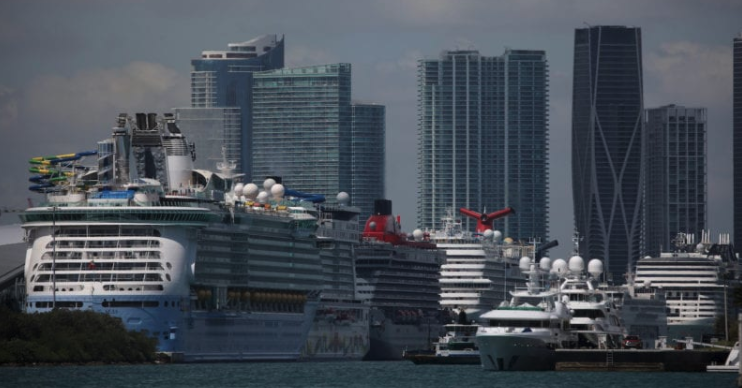The Cruise Industry’s War Against COVID-19
By Salvatore R. Mercogliano, Ph.D./gCaptain
By Salvatore R. Mercogliano, Ph.D. – On Friday, March 13, 2020, the Cruise Lines International Association (CLIA) announced that their ocean-going cruise lines would be, “voluntarily and temporarily suspending cruise ship operations from U.S. ports of call for 30 days as public health officials and the U.S. Government continue to address COVID-19.” This decision followed on the heels of many shipping lines, making similar choices and marked a historic event.
The outbreak of the Coronavirus gripped most western news sources when the plight of the Diamond Princess in Yokohama, Japan began to unfold. It was followed by the Grand Princess off San Francisco, and others around the world. Some cruise ships, such as Westerdam of Holland-American Lines, found themselves unable to offload their passengers in any ports, a veritable Flying Dutchman. With the suspension of cruises and most vacationers offloaded, the ships are docked or at anchor around the world awaiting a callback. But what that call entails, no one is quite sure.
Over a century ago, the world was in the grip of a global conflict. Stemming from a seemingly insignificant event in the city of Sarajevo on June 28, 1914, within the span of five weeks, the world had been upended. Fighting had erupted in Europe and it would spread like a virus across the Old World, to Africa and Asia, and upon the high seas and even as far away as Bar Harbor, Maine.
On August 4, 1914, the small northern Maine town, the summer resort of the rich and famous was awaiting the arrival of Vincent Astor on board his yacht Noma. One of the stories in the papers was that of the North German Lloyd liner SS Kronprinzessin Cecilie. She had sailed from New York to Germany with over 1,200 passengers. As one of the largest German liners, she was a prize for any British warship that could capture her, for in her hold were $10 million in gold and $3 million in silver to fund the war effort.
That morning, with reports that the ship was making a dash north of the British Isles, the residents and visitors of Bar Harbor awoke to the sight of Kronprinzessin Cecilie swinging from her anchor off The Porcupines. A few days earlier, the ship’s master, Charles Polack, met with the first and second-class male passengers to discuss a strategy to avoid the British and French warships on the prowl for the liner. Among the passengers was C. Ledyard Blair, a New York investment banker who was sailing to Scotland for grouse hunting. An avid yachtsman, he informed Captain Polack of Bar Harbor and volunteered to pilot the vessel to the anchorage, since he owned a cottage and sailed those waters every summer.
After its arrival and with the passengers offloaded, she sailed to Boston, staying within three miles of the New England coast to avoid capture. She, along with other German and Austrian liners, were interned in the United States and neutral ports around the world. The ships lingered for nearly three years. Other passenger liners served as auxiliary cruisers and some became noteworthy, such as when RMS Lusitania met her fate off southern Ireland at the hands of U-20 on May 7, 1915. The interned liners, such as Kronzprinzessin Cecilie, awaited the end of the war to return back to service, but Germany’s resumption of unrestricted submarine warfare in early 1917, and the sinking of ten American ships and the loss of 64 merchant mariners led to the United States entering the war.
German crews, living onboard, sabotaged the vessels with the aim to prevent them from falling into American hands. They envisioned that their efforts would require at least two years of repairs, since the Americans lacked the schematics and parts. However, American naval engineers and U.S. Navy shipyards were able to utilize new techniques, such as electric welding, to return the ships to service in under six months. Kronprinzessin Cecilie joined the U.S. Navy as USS Mount Vernon. She and nineteen other former German and Austrian vessels carried over 500,000 doughboys of the American Expeditionary Force to France. In World War Two, this was repeated when interned liners and those seeking refuge from the Axis powers were used to transport forces around the globe.
Today, the three mega-cruise lines – Carnival, Royal Caribbean, and Norwegian – are scrambling to ride out this storm, much as the German liners did at the start of the First World War. In the Bahamas, over a dozen ships are riding at anchor, while in ports around the world, others are tied up at the docks awaiting a return to normalcy, that may not come any time soon. Taking a page out of history, the cruise lines, which were the early focus of the COVID-19 outbreak, much like Kronprinzessin Cecilie was early in the First World War, may be part of the solution to this issue.
The fear of COVID-19 is that the virus will swamp existing medical facilities and expose additional people. Nations around the world have

